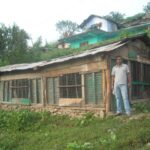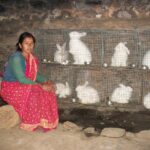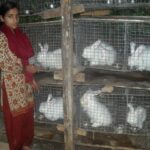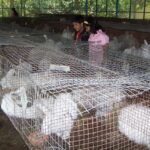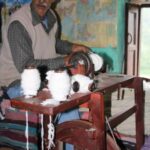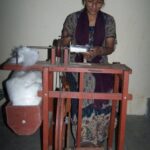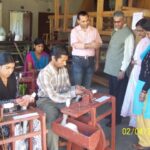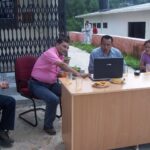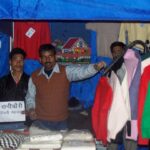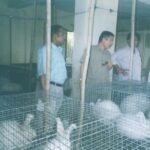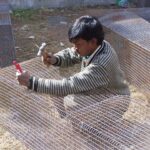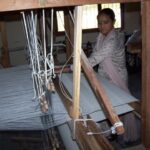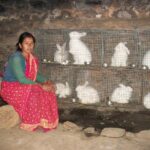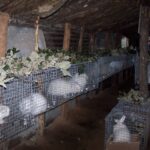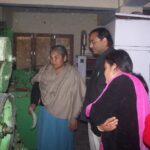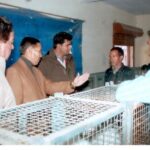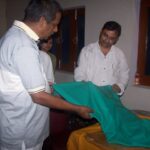DEVELOPMENT OF ANGORA WOOL SECTOR FOR TRIBALS
DEVELOPMENT OF ANGORA WOOL SECTOR FOR TRIBAL COMMUNITIES IN DISTRICT TEHRI GARHWAL OF UTTARAKHAND
INTRODUCTION AND BACKGROUND OF THE PROJECT
The hilly regions of Uttarakhand have long depended on agriculture and animal husbandry; however, their potential is constrained by challenging terrain and agro-climatic conditions. Traditional sheep rearing has declined due to grazing challenges and shrinking pastureland, creating a need for alternative solutions like angora rabbit farming. This venture not only meets wool demand but also elevates clothing quality and rural economies. Propagating angora rabbit farming in Uttarakhand’s hilly areas is imperative for sustainable economic growth. Agriculture and animal husbandry in these regions yield suboptimal economic returns. To invigorate the hill economy, diversification through angora rabbit breeding and rearing is crucial. Angora rabbit wool, characterized by its high quality, commands substantial demand and premium prices in global markets. Consequently, the economic landscape of Uttarakhand’s hilly regions stands to significantly benefit from the integration of angora rabbit farming. The inherent attributes of angora rabbits, such as their fast reproduction rate and short generation interval, enable efficient selection and improvement, distinguishing them from other livestock. Applying scientific methodologies to breeding, feeding, management, and wool processing can substantially enhance wool production within angora rabbit units. The core objective of this project is to elevate technical expertise, streamline input supply, and establish robust marketing infrastructure, culminating in heightened economic gains from angora rabbit breeding. Over the past years, angora rabbit breeding has evolved into a prominent income source within hilly regions. It provides a sustainable income avenue for those with limited agricultural holdings. Uttarakhand’s hilly terrain, ranging from 4000 to 7000 feet above sea level, presents fertile ground for this enterprise.
The profitability, income generation potential, employment opportunities, capacity for foreign exchange earnings, and ecological rehabilitation contributions all underscore the necessity for coordinated endeavours to bolster angora rabbit breeding. Promoting angora rabbit breeding and rearing carries the potential to amplify angora wool production, extending benefits to traditional farmers, women, and unemployed youth. The practice demands minimal space, time, and financial investment, rendering it accessible to family members with basic training. The rapid multiplication rate of angora rabbits further accelerates their growth. The climatic conditions prevalent in Uttarakhand’s hilly regions are conducive to successful angora rabbit breeding. Despite its promising profitability, angora rabbit farming faces hurdles including restricted access to superior germplasm and limited understanding of economic feasibility. Challenges persist in marketing avenues, feed availability, and addressing health concerns, resulting in impediments to growth. These barriers persist despite commendable efforts by diverse agencies, leading to delayed returns for breeders. In response to these challenges, HIFEED has launched this project. It encompasses comprehensive training programs spanning angora rabbit breeding and rearing, wool production, processing, spinning, and weaving.
The project’s core objective is twofold: empowering women, unemployed youth, and traditional farmers, and establishing decentralized angora rabbit, spinning, and weaving units. These units are designed to uplift economically marginalized segments within the tribal community. The proposed project entails the establishment of a germplasm resource center, enhancement of breeding practices, provision of training, extension of rabbit units to households, establishment of a wool processing facility, and implementation of a production and marketing program for angora wool products. This integrated approach aims to foster sustainable growth in angora rabbit breeding, while also providing income and employment opportunities for farmers, women, and unemployed youth across Uttarakhand’s hilly regions. HIFEED’s pioneering endeavour, the Integrated Angora Rabbit Wool Development Program, is meticulously designed to amplify angora wool production, enhance marketing, and drive sales. This initiative involves comprehensive training for partner NGOs in various aspects of angora rabbit breeding and rearing, wool production, processing, spinning, and weaving. The project’s establishment of angora rabbit, spinning, and weaving units at household levels within Uttarakhand’s hilly areas holds the promise of generating employment opportunities and augmenting family incomes.
AIMS AND OBJECTIVES OF THE PROJECT
1. Introduce Angora Rabbit Rearing: Initiate Angora rabbit rearing as a supplementary source of income for mountain tribal families in Uttarakhand, fostering economic empowerment.
2. Comprehensive Training Programs: Organize and deliver comprehensive training modules encompassing Angora rabbit breeding, rearing, shearing, optimal feeding practices, effective management techniques, wool production intricacies, and efficient processing methods.
3. Household-level Units Establishment: Set up decentralized Angora rabbit, spinning, and weaving units at the household level, strategically focusing on hilly and tribal villages to ensure localized economic development.
4. Localized Rabbit Feed Development: Innovate rabbit feed formulations utilizing locally available raw materials, thus curtailing input costs for farmers and enhancing sustainability.
5. Buy-Back Facility Implementation: Implement a well-structured buy-back system for Angora wool, yarn, and finished products, guaranteeing timely remuneration for breeders and fostering a symbiotic relationship.
6. Sustainable Value Chain Creation: Forge a robust and sustainable value chain around Angora rabbit farming, thereby uplifting the economic stature of mountain tribal families in Uttarakhand, contributing to their overall prosperity.
COMPONENTS AND ACTIVITIES OF THE PROJECT
1. Promote the promotion of Angora rabbit farming as a viable avenue for fostering sustainable income within rural communities.
2. Provide an extensive array of training and technical assistance to breeders, Self-Help Groups (SHGs), and extension workers, enriching their proficiencies in various aspects of Angora rabbit farming.
3. Establish household-level Angora rabbit wool production units, offering an additional income stream that empowers local communities economically.
4. Implement scientific methodologies encompassing breeding, rearing, and record management, elevating both production quality and operational efficiency.
5. Craft and execute refined practices pertaining to breeding, feeding, disease control, and overall production enhancement.
6. Erect a dedicated Common Facility Centre (CFC) meticulously designed for the streamlined processing of Angora wool, culminating in a diverse array of yarn and finished products.
7. Cultivate a resilient network, overseeing the entire lifecycle of Angora wool, commencing from production and culminating in comprehensive marketing strategies.
8. Foster the development of a sustainable value chain, guaranteeing equitable returns and contributing to economic stability for Angora rabbit breeders.
TARGET AREA OF THE PROJECT
The project was deliberately executed within the Jaunpur block of the Tehri Garhwal district in Uttarakhand. The selection of this area was driven by its suitability for angora rabbit farming, attributable to its hilly topography and favorable climatic conditions.
TARGET GROUPS AND BENEFICIARIES OF THE PROJECT
The project primarily catered to low-income families and tribal communities residing within the Jaunpur block of the Tehri Garhwal district in Uttarakhand.
FUNDING PARTNER OF THE PROJECT
The funding for the project was provided by the Department of Science & Technology (DST), Ministry of Science & Technology, Government of India, New Delhi.
SANCTIONED BUDGET OF THE PROJECT
The DST sanctioned the budget for the project on March 23, 2009, with the sanction order number SP/TSP/056/2007. The total budget sanctioned for the project was Rs. 17,19,000.00 for a period of three years.
OUTCOMES AND ACHIEVEMENTS OF THE PROJECT
The successful implementation of the Development of Angora Wool Sector Program for Tribal has yielded the following notable outcomes and achievements:
1. A comprehensive array of training programs has been meticulously organized, encompassing various facets of angora rabbit breeding, rearing, shearing, feeding, management, wool production, and processing.
2. At the grassroots level of hilly and tribal villages, 30 angora rabbit units, 30 spinning units, and 30 weaving units have been established within farmer households, invigorating the angora wool sector.
3. Scientists from the organization have ingeniously formulated a rabbit’s concentrate feed using locally available raw materials, effectively reducing input costs for farmers while maintaining nutritional excellence.
4. By offering a buy-back mechanism for angora wool, yarn, and end products, a system has been instituted to ensure prompt and fair remuneration for breeders, thus enhancing the economic stability of the sector.
5. Robust technical support has been extended to angora rabbit breeders, self-help groups (SHGs), and extension workers, spanning the spectrum of angora rabbit breeding and rearing, wool processing, spinning, weaving, knitting, designing, dyeing, and related disciplines.
6. The implementation of scientific and systematic breeding and rearing practices, alongside diligent record management, has been instigated to elevate the calibre of angora rabbit production.
7. The establishment of a Common Facility Centre (CFC) at the community level, dedicated to carding, blending, spinning, weaving, knitting, and processing raw angora wool into yarn and hand-crafted finished products, stands as a significant accomplishment that empowers farmers to access essential processing facilities and value-added services, ultimately leading to increased income generation.
8. The creation of an integrated network for the production and marketing of raw angora wool, angora wool blended yarn, and finished hand-made angora woollen products has been a pivotal feat, forging a sustainable value chain within the angora rabbit farming domain and assuring timely returns for breeders.




